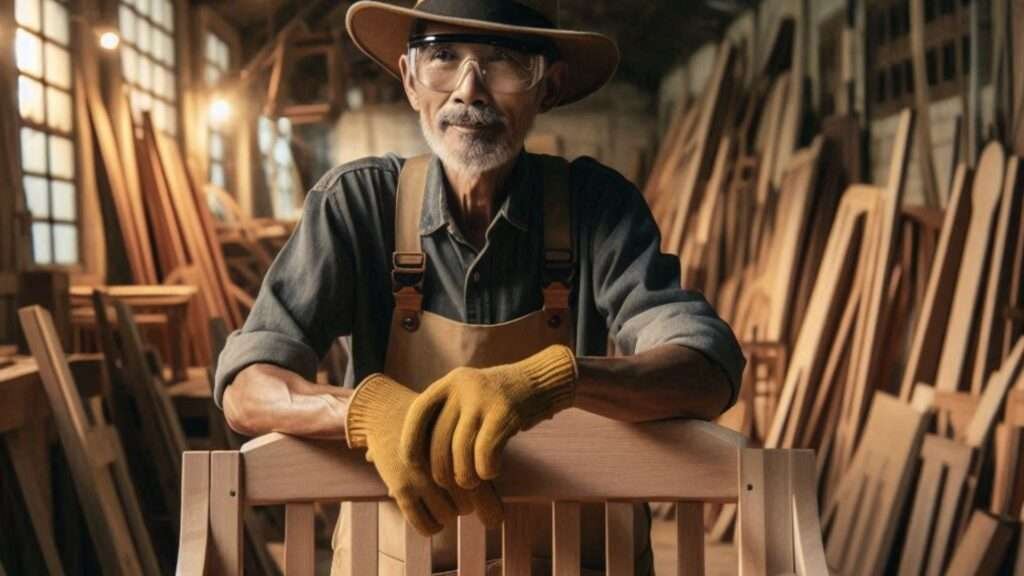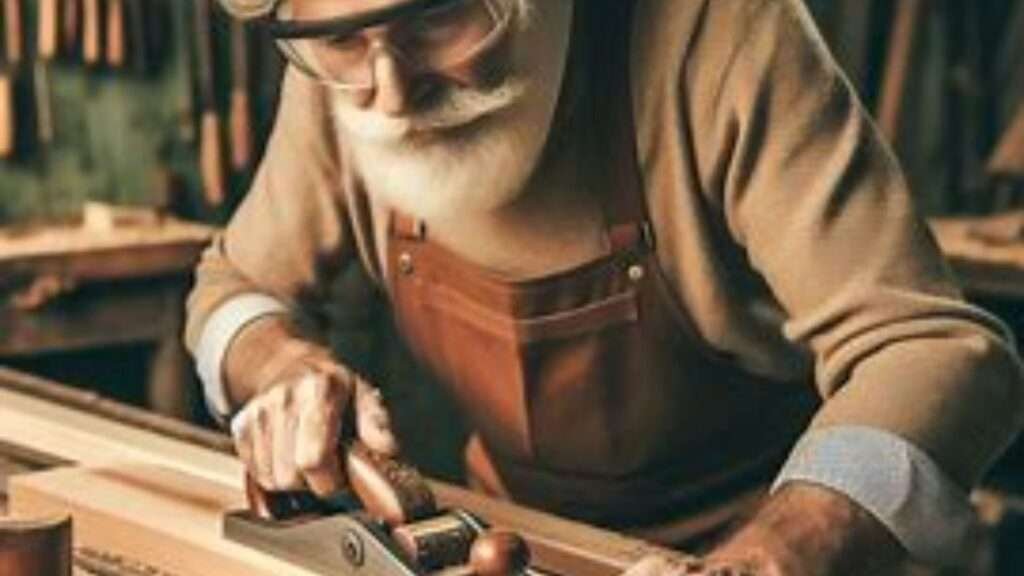The Factors That Have Affected Furniture Design And Production.
With this article I’ll be exploring the multifaceted evolution of furniture design and production throughout history.
I’ll be looking at the various factors that have shaped how we make furniture as an individual craftsperson and in the industry as a whole.
I will look at the intersection of traditional craftsmanship and modern technology, highlighting how historical techniques and contemporary innovations have combined to create today’s diverse furniture landscape.
This article will discuss important topics such as material selection, with a focus on wood species and their distinct characteristics, as well as how material availability has influenced design trends.
I will also look at technological advancements that have revolutionised production methods, ranging from 19th-century innovations to modern computer-aided design tools.
I’ll also be discussing democratised furniture design, which has made high-quality pieces more accessible to a very wide audience.
Special attention will be given to the pursuit of perfection in furniture craftsmanship, the role of ornamentation across different periods and the increasing importance of sustainability in modern furniture production.
I’ll finish things up by highlighting how the woodworking and in particular the furniture making industries continue to evolve through the balanced integration of traditional methods, technological innovation and environmental consciousness.
Table of Contents.
1.0 Introduction: The Evolution of Furniture Design.
2.0 Traditional Craftsmanship Met Modern Technology.
3.0 It’s A Quality Driven Furniture Material Selection World.
4.0 Understanding Wood Species and Their Characteristics.
5.0 Innovation and Its Impact on Furniture Design.
6.0 The Pursuit of Perfection in Furniture Craftsmanship.
7.0 Historical Recreation and Modern Techniques.
8.0 Technology’s Influence on Design Principles.
9.0 What Role Has Ornamentation Played in Furniture Design?
10.0 Influence of Wood Availability on Design Trends.
11.0 Conclusion: The Evolution and Future of Furniture Design.
1.0 Introduction: The Evolution of Furniture Design.
Just like the history of woodworking, the history of furniture design is a remarkable journey that reflects how we cater for basic needs, changing societal values, technological advancements and aesthetic sensibilities.
Its evolution can be traced through various periods and styles, each contributing unique characteristics that shape the furniture industry today.
From the primitive needs of early human settlements to the ornate pieces of contemporary design, furniture has transformed dramatically.
Each era has marked a distinct shift in its function, material, and form.
In ancient civilizations, furniture primarily served useful purposes, focusing on function rather than aesthetics.
The Egyptians, for instance, designed simple yet robust pieces that supported daily life.
As societies progressed, particularly during the Renaissance in Europe, furniture design began to incorporate artistry and elegant craftsmanship.
This period introduced intricate detailing and opulent materials, transitioning the focus from pure functionality to carefully crafted aesthetic appeal.
The Baroque and Rococo movements further emphasized artistic expression in furniture design. Curves, lavish ornamentation, and exquisite finishes became hallmarks of these styles, reflecting the wealth and status of their patrons.
With the Industrial Revolution came the introduction of machine-made furniture, which made design more accessible to the masses.
However, this shift also sparked a reaction that gave rise to the Arts and Crafts movement, advocating for handmade quality and simplicity in design.
As the 20th century unfolded, modernism redefined furniture aesthetics by prioritising minimalist functionality over elaborate designs.
This era introduced innovative materials and construction techniques, paving the way for contemporary furniture design, which now combines sustainability with technological advancements.
The evolution of furniture design remains ongoing, as current trends continue to blend historical influences with modern innovations, reflecting the socio-economic dynamics of our time.
2.0 Traditional Craftsmanship Met Modern Technology.
The intersection of traditional craftsmanship and modern technology in furniture design presents an intriguing paradigm that not only honours age-old techniques but also embraces the innovation that contemporary tools provide.
As the demand for unique, bespoke furnishings grows, designers increasingly find themselves looking back to ancestral skills while also considering modern production methods that enhance both efficiency and precision.
Traditional woodworking techniques, which have been handed down through generations, encompass a profound understanding of material properties, aesthetics, and structural integrity.
Skills such as hand-carving, joinery and finishing involve a level of artistry and dedication that is fundamental to high-quality craftsmanship.
Woodworkers & other wood craftspeople often use a limited array of tools to create pieces infused with individuality and cultural significance.
However, merging these ancient practices with modern technology allows for the expansion of possibilities in design and production.
Innovative technologies such as computer-aided design (CAD) software and CNC (Computer Numerical Control) machinery empower designers to achieve greater accuracy and repeatability in their work.
These tools facilitate detailed planning, allowing for complex geometries and intricate patterns that might be unfeasible to execute by hand.
By utilizing these advanced methods, furniture makers can efficiently produce items that maintain the essence of traditional craftsmanship while catering to contemporary consumers’ appetites for diversity and customisation.
The incorporation of sustainable materials and eco-friendly production processes into modern furniture design harmonizes with the values of traditional craftsmanship.
There is a collective push towards the use of responsibly sourced wood and innovative materials derived from recycled resources, all of which reflect a commitment to preserving the environment.
This soulful collaboration between the time-honoured methods of artisan craftsmen and the technological advancements in machinery and materials cultivates a new landscape for furniture design.
It ultimately produces items that are not only functional and attractive but also rich in history and significance.
3.0 It’s A Quality Driven Furniture Material Selection World.
The selection of materials is a critical aspect of furniture production, influencing not only the durability and aesthetics of the final product but also its functionality.
High-quality materials lead to furniture that can withstand the test of time, both in terms of physical wear and changing design trends.
Among various materials available, wood stands out as a premier choice due to its myriad qualities. Different tree species, each with unique properties, contribute significantly to the overall effectiveness of wooden furniture.
In furniture making, the grain pattern, colour, and texture of wood can enhance visual appeal. For instance, hardwoods such as oak, cherry, and walnut are favoured for their beauty and strength, making them ideal for high-end furniture pieces.
These woods are known for an impressive level of durability, withstand frequent use, and resist scratches and dents, ensuring that furniture retains its aesthetic charm over the years.
On the other hand, softer woods like pine and cedar offer a warm and rustic appeal, perfect for casual and cozy furniture designs.
Furthermore, the sustainability of wood is an increasingly relevant consideration in material selection.
With the rise of environmentally conscious consumers, responsible sourcing of timber has gained importance.
Materials that are harvested from sustainable forests contribute to ecological balance, making them more desirable in today’s market.
This not only ensures the longevity of tree species but also aligns with growing consumer demand for ethical production practices.
Ultimately, quality-driven material selection, particularly in wood, encompasses a balance between aesthetics, practicality, and sustainability.
By carefully evaluating the characteristics of different tree species, furniture designers and manufacturers can create pieces that not only fulfil functional requirements but also resonate with consumers’ values and preferences.
4.0 Understanding Wood Species and Their Characteristics.
When it comes to furniture design and production, the choice of wood species plays a crucial role.
Each type of wood possesses unique characteristics that influence both the aesthetic appeal and functional aspects of furniture.
Understanding these traits can help designers make informed decisions tailored to specific styles and applications.
Cedar is renowned for its natural resistance to decay and insects, making it an excellent choice for outdoor furniture.
Its aromatic properties and rich reddish-brown hue contribute to its popularity, particularly in rustic and traditional designs.
Another softwood, pine, is characterized by its light colour and ease of workability.
It tends to be more affordable and can be finished in various ways, lending itself well to contemporary as well as traditional furniture styles.
Maple, a hardwood, offers remarkable durability and strength. Its fine and uniform grain allows for a smooth finish, often seen in modern furniture.
The light, creamy colour of maple provides a versatile canvas that can complement diverse interior designs.
In contrast, oak is celebrated for its robust structure and distinctive grain patterns, which can add character to furniture pieces.
Available in red and white varieties, oak is frequently used in both traditional and transitional styles.
Redwood’s natural resistance to weathering makes it a very popular choice for both outdoor furniture and structures.
Its rich colour and straight grain enhance its desirability in gardens and patios. Hickory, another sturdy hardwood, is often sought for its flexibility and shock resistance, ideal for items subjected to heavy use.
Last but certainly not least, mahogany is recognized for its deep, reddish-brown tones and fine grain, often associated with luxury furniture.
It is a gorgeous wood and highly prized in classical and formal designs due to its capacity for intricate detailing and enduring beauty.
In understanding the various wood species and their unique characteristics, designers can create furniture that is not only functional but also aesthetically pleasing, catering to a wide range of consumer preferences.
5.0 Innovation and Its Impact on Furniture Design.
The 19th century marked a significant turning point in furniture design, characterized by several technological advancements that transformed both production processes and design principles.
Among these innovations were the development of steam-powered machinery, the introduction of the band saw and the proliferation of factory methods, which collectively facilitated the mass production of furniture.
These machinery advancements enabled those in the woodworking centric world to produce furniture faster and more efficiently, allowing for a wider variety of styles and designs that catered to evolving consumer preferences.
One of the most noteworthy innovations of this period was the mechanization of the woodworking industry.
The introduction of machinery such as lathes, planers and saws streamlined various manufacturing processes, reducing the time craftsmen had to invest in each piece.
This shift not only lowered production costs but also made furniture more accessible to the average consumer.
The capacity for large-scale production meant that previously custom-made items became available to a broader audience, effectively democratising furniture design.
Just to explain, the phrase “democratising furniture design” refers to the process of making high-quality, well-designed furniture accessible to a wider range of people, rather than being limited to only the rich.
This phrase came about due to 5 factors that I can think of:
1. Mass production: The advent of industrial manufacturing methods made it possible to produce furniture in greater quantities and at a reduced cost.
2. New materials: As a result of technological developments, furniture is now made from new, more reasonably priced materials.
3. Simplified designs: In contrast to elaborate, labour-intensive styles, modern furniture design frequently placed an emphasis on functionality and simplicity.
4. Affordability: As production costs decreased, furniture became more reasonably priced for the average consumer.
5. Accessibility: Well-designed furniture that was previously unaffordable is now within the reach of a wider range of people.
This democratisation of furniture design is consistent with the “the best for the most for the least” philosophy of designers such as Charles and Ray Eames. Their mission was to revolutionise home furnishings by introducing fashionable, high-quality furniture to middle-class Americans.
Additionally, the idea is related to the more general concept of “Democratic Design,” which is basically IKEA’s strategy.
The goal of this philosophy is to make well-designed furniture affordable for “the many people” by balancing form, function, quality, sustainability and affordability.
Fundamentally, democratising furniture design entails removing the barriers that previously limited high-end design to the wealthy, allowing a wider range of people to appreciate and profit from well-made, aesthetically pleasing, and functional furniture.
Furthermore, as a result of technological advancements, the nineteenth century saw an emphasis on uniformity and standardisation in design.
Manufacturing techniques enabled the replication of specific forms and styles, resulting in the emergence of iconic furniture items recognised by a large audience.
This period also saw the introduction of new materials, such as veneers and engineered wood, allowing designers and manufacturers to experiment with textures and finishes that were previously unavailable.
The technological innovations of the 19th century certainly had a profound impact on furniture design.
The transition from a woodworkers craftsmanship to industrial production not only bolstered the quantity and variety of furniture available but also shifted consumer preferences towards more innovative and standardized designs, forever changing the landscape of furniture production.
6.0 The Pursuit of Perfection in Furniture Craftsmanship.
“Perfect is the enemy of good” is a saying that suggests that obsessing over making something perfect can prevent us from completing something that would be perfectly adequate or good enough.
Sometimes getting something done well is more valuable than endlessly pursuing an unattainable level of perfection.
There is certain a case for perfection when it comes to woodwork and in particular furniture making though but that is very much a 1st world problem isn’t it? Sometimes people just want a dam chair to sit on!
The concept of ‘perfect creation’ in furniture design serves as a guiding principle for artisans and manufacturers alike.
High-quality craftsmanship is characterized by meticulous attention to detail, an understanding of materials, and a strong commitment to sustainability.
What distinguishes premium furniture from mass-produced pieces lies not only in the materials used but also in the skill and expertise of those who create it.
Heaps of woodworkers often employ time-honoured techniques, investing hours or even days into constructing a single piece, which ultimately reflects the dedication poured into its making.
One significant attribute defining top-tier craftsmanship is the use of premium materials.
Quality woods, metals and textiles contribute to the overall durability and aesthetic appeal of a piece.
Furniture made of solid hardwood, for example, not only adds character to an item but also ensures longevity, as opposed to the often fleeting nature of mass-produced alternatives.
Furthermore, eco-sustainability is increasingly becoming a factor in the pursuit of perfection, with many artisan creators sourcing materials from responsibly managed forests or recyclable resources.
The quest for perfection also encompasses innovative design methodologies. As technology advances, modern furniture makers are integrating new tools and techniques into their workshops that enhance precision and creativity.
Computer-Aided Design (CAD) programs allow for intricate designs that might be impossible to achieve through traditional methods alone.
However, the heart of furniture design remains rooted in human creativity and craftsmanship, where hands and minds work in harmony to achieve excellence.
The elevation of furniture through exceptional craftsmanship relies on a blend of time-honoured traditions, quality materials, modern technology and a good eye for detail.
By striving for perfection, woodworkers not only elevate the standard of their creations but also contribute to a burgeoning appreciation for fine furniture in an age dominated by mass production.
7.0 Historical Recreation and Modern Techniques.
The process of recreating historic furniture pieces presents a unique set of challenges that blend the artistry of traditional craftsmanship with contemporary technological advancements.
I guess it’s not that much different to when we talking about doing a restomod on classic car from the 60’s or 70’s.
Authenticity remains a critical criterion in this process, emphasizing the need for a deep understanding of both historical styles and construction methods.
Woodworkers involved in this endeavour must take a meticulous approach to ensure that every detail, from material selection to finishing techniques, accurately reflects the original piece.
One of the foremost challenges in historical recreation is sourcing appropriate materials that match the original specifications.
Many classic pieces were constructed using specific tree species that may now be rare or unavailable. Hence, contemporary artisans often need to find suitable substitutes or ethically sourced alternatives that can replicate the aesthetic and structural properties of the historic woods.
This decision impacts not only the overall look of the furniture but also its durability and longevity.
In addition to material selection, the skills required for crafting such furniture have evolved.
Artisans must possess a hybrid skill set that encompasses traditional techniques and familiarity with modern tools.
While hand tools remain vital for many intricate tasks, the integration of advanced machinery can enhance precision and efficiency in tasks that may have been labour-intensive in past eras.
The challenge lies in balancing these innovative techniques with handcrafting methods that respect the integrity of the original designs.
Furthermore, artisans often face the dilemma of adhering to tradition while incorporating modern insights and methodologies.
This balancing act enables them to produce pieces that honour historical significance while also catering to contemporary aesthetics and usability.
Ultimately, the successful merging of historic styles with modern techniques creates distinctive, high-quality furniture that resonates with diverse audiences, ensuring that the legacy of past craftsmanship continues to thrive in today’s design landscape.
8.0 Technology’s Influence on Design Principles.
The evolution of technology has significantly reshaped the landscape of furniture design and production, introducing modern woodworking equipment that has enhanced both aesthetics and functionality.
Historically, furniture design was often constrained by the limitations of manual tools and techniques.
However, the advent of CNC (Computer Numerical Control) machines has revolutionized the industry.
These machines allow for precise cutting, milling, and shaping of materials, resulting in intricate designs that were previously unattainable.
As a result, designers have been able to explore more complex geometries and patterns, leading to a new era of creativity in furniture design.
Modern technology has not only improved precision but also enabled the rapid prototyping of furniture pieces.
Tools such as 3D printing have opened up new avenues for innovation, allowing designers to experiment with unconventional shapes and forms without the need for extensive manual labour.
This process not only reduces material waste but also shortens the time from concept to market.
As a result, the furniture industry has seen an increase in versatile designs that meet a wide range of consumer preferences and needs.
Similarly, technological advancements have made ergonomic principles more effective in furniture design.
Designers use data analytics and user feedback to create products that are not only visually appealing, but also comfortable and easy to use.
Adjustable desks and chairs, for example, have grown in popularity as technology has enabled manufacturers to better understand the ergonomic needs of various users.
This has led to a significant shift in how furniture is perceived; it is no longer merely an aesthetic addition to a space but a crucial component of well-being and functionality.
Without a doubt, the influence of modern technology on furniture design principles is profound.
The integration of CNC machinery, 3D printing, and ergonomic research has paved the way for innovative and functional designs.
This ability to combine creativity with technological advancement continues to define the future landscape of the furniture industry.
9.0 What Role Has Ornamentation Played in Furniture Design?
Ornamentation’s significance in furniture design has changed dramatically over time, serving not only as a decorative element but also as a reflection of cultural values, social hierarchy, and aesthetic philosophies of the time.
In antiquity, ornamentation was frequently symbolic, with intricate carvings and motifs expressing religious beliefs or social status. For example, in ancient Egypt, furniture featured elaborate carvings that honoured the gods and reflected the importance of the afterlife, demonstrating how ornamentation was essential to both function and belief systems.
During the Renaissance, a notable shift occurred as ornamentation began to embrace humanism and individualism.
Pieces from this period tended to showcase elaborate woodwork, inlays, and gold leaf to illustrate artistic mastery and wealth.
The use of motifs such as foliage, shells, and figurative scenes became prevalent, indicating a preference for naturalistic designs and classical references.
This ornamentation was not merely decorative; it communicated the tastes and aspirations of the elite, reinforcing social distinctions through the lavishness of their furnishings.
As the Baroque period emerged, ornamentation further intensified, characterized by dramatic contrasts, opulence, and grandeur.
Furniture from this era often featured bold carvings, intricate scrollwork, and lavish upholstery, embodying the ethos of theatricality and exuberance.
The Rococo style that followed emphasized curves and asymmetry, emphasizing ornamental details that celebrated romance and intimacy.
This stylistic shift mirrored the changing societal values and brought a sense of playfulness to interior spaces.
In the 19th century, ornamentation witnessed a blend of historical styles during the Victorian era, reflecting a fascination with the past while also embracing industrial advances.
The introduction of new technologies allowed for mass production, which democratised ornamentation in furniture design.
This period illustrates how ornamentation evolves alongside societal changes, revealing the shifting aesthetics and values that define each era.
10. Influence of Wood Availability on Design Trends.
The historical landscape of furniture design has been significantly shaped by the availability of various tree species.
The types of wood that were locally accessible often dictated not only the aesthetics but also the functionality of furniture crafted in past years.
For instance, in regions abundant with oak and pine, these woods became the go-to materials for crafting durable furniture, largely due to their strength and workability.
As trade routes developed and cultures exchanged resources, the adoption of imported woods such as mahogany and teak introduced new design paradigms that captivated artisans and consumers alike.
In more recent times, the global movement towards sustainability and environmental awareness has led designers to re-evaluate the types of wood utilized in furniture making.
While traditional hardwoods remain popular, less commonly used species are receiving renewed attention.
Woods such as bamboo, acacia, and even reclaimed wood are being embraced for their unique aesthetic qualities and lower environmental impact.
These materials not only contribute to the beautification of spaces but also align with the principles of sustainable design, ensuring that furniture making does not come at the cost of depleting local resources.
This shift in material selection reflects a broader trend in the design community to prioritise ecological responsibility.
Furthermore, the development of novel techniques and technologies has enabled the incorporation of previously underutilised woods into mainstream furniture production.
Precision crafting is made possible by advanced woodworking machinery, so even species that were previously thought to be too difficult to work with can now be effectively manipulated.
This changing landscape of wood availability is sparking a lively discussion about sustainability and innovation, encouraging designers to experiment and reduce reliance on traditional materials, paving the way for a more diverse and environmentally responsible approach to furniture design.
11.0 Conclusion: The Evolution And Future of Furniture Design.
This articles exploration of the various factors influencing furniture design and production over the many years reveals a complex interplay of tradition, innovation and adaptation.
From ancient civilisations to the present, furniture design has consistently reflected societal values while adapting to technological advancements and material availability.
The combination of traditional craftsmanship and modern technology has resulted in a dynamic landscape in which historical techniques and contemporary innovations coexist and complement one another.
The quality-driven approach to material selection, particularly in wood species, remains fundamental to furniture production.
Understanding the distinct characteristics of various wood species continues to influence our design decisions, while sustainable practices are increasingly influencing material selection.
There’s a few very good woodworkers in this world that embody a philosophy of sustainability and resourcefulness in their woodworking practices.
They will actively seek out fallen trees, often those downed by storms or cleared for development, rather than cutting down healthy trees for their various projects.
This approach reflects a commitment to making the most of unfortunate circumstances, turning what might be seen as waste into beautiful, handcrafted pieces and I think a lot of these people that do this.
By prioritising the use of these fallen trees, they not only honour the natural world but also encourage others to appreciate the value in materials that are often overlooked.
Their work in this space serves as a reminder that creativity can flourish even in challenging situations.
Ultimately, this dedication from those particular woodworkers to sustainable practices highlights a deep respect for nature and the resources it provides.
The democratisation of furniture design, fueled by nineteenth-century innovations, has shifted the industry away from exclusive craftsmanship and towards affordable production without sacrificing quality.
As we look ahead, the quest for perfection in furniture craftsmanship continues, albeit with new tools and perspectives.
Historical recreation techniques blend seamlessly with contemporary methods, and technological advancements continue to broaden design and production possibilities.
Ornamentation has progressed from purely decorative to functional and sustainable, reflecting changing cultural values and environmental concerns.
The availability and selection of wood species remain critical factors in design trends, particularly as sustainability becomes more important.
This evolution demonstrates how furniture design can and will adapt to new challenges while maintaining its rich heritage.
As we move forward, the industry’s ability to balance traditional craftsmanship, technological innovation and environmental responsibility will be critical in shaping the future of furniture design and manufacturing.
Let’s pass on some great values to the young woodworkers out there!








